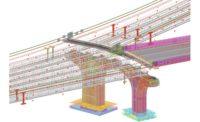Civil infrastructure is starting to catch up to buildings in terms of adopting 3D modeling, as companies like Autodesk Inc. expand their suite of tools to include transportation. A new alliance between Autodesk and Virgin Hyperloop One (VHO) aims to push transportation route optimization, digital engineering and construction workflows for transportation even further.
The companies announced the agreement Nov. 20 at Autodesk University (AU) in Las Vegas. “Virgin Hyperloop One is pushing the boundaries of transportation efficiency,” said Josh Giegel, co-founder and chief technology officer for the company, in a statement. “Virgin Hyperloop One and Autodesk will explore ways to optimize hyperloop routing and operations in a way that not only propels the hyperloop industry forward, but also has ancillary benefits to more traditional forms of transportation such as railway and highway route optimization.”
VHO’s technology features depressurized tubes that carry on-demand passenger or cargo pods at speeds of up to 670 miles per hour, powered by magnetic-levitation and electric propulsion. Rather than stations, the pick-up points will be called portals, said Min-Tak Cheung, VHO senior design architect, at a transportation summit during AU. A prototype portal has been built in India, and VHO is partnering with architects such as Foster and Partners, he adds.
BIM is already helping automate repetitive tasks on civil works, including rock bolting and tunnel cross-passages, said Jerome Chamfray, chief geodigital engineer with Jacobs. Generating and choosing options for earthwork and retaining wall construction can be done in days rather than weeks, he said.
Civil contractors spend five million hours a year measuring quantities, said Eric Cylwik, virtual construction engineer with Sundt Construction. “It can take a month to revise a design. You had to document, interpret, and give feedback.” If that process is streamlined through BIM tools, “constructors can focus on means and methods,” he said.
Owners can also use virtual tools to save money and time during the bid process, said Jamie Waller, assistant director of construction for the Tennessee Dept. of Transportation. The agency started a pilot program using PlanGrid to distribute bid documents both internally and externally, saving over 500,000 sheets of paper and 123 hours of work, she said.
As of March this year, the winning contractor on a project is required to register with PlanGrid software before preconstruction, she said.
Mohammed Al Ktaishat, digital project delivery lead for AECOM Middle East, said that reality capture using drones, 360° cameras and Lidar saved 32% in time spent inspecting a rail project.
|
Related Article |
Aiming High
BIM and digitization will play a major role not only in design and construction, but in asset management as Heathrow Airport embarks on a £50-billion capital program, said Nigel Stroud, expansion information management lead with the airport.
The 30-year master plan includes relocating four rivers and a motorway, building a new runway and nearly doubling passenger capacity, he said.
The airport is creating a digital environment that eliminates file-based exchanges and creates “a single source of asset information,” he said.
In London, a £5-billion project aims to increase motorway capacity between London, Leeds, Manchester and Birmingham by one-third using technology, said Liam Gallagher, director of digital delivery with Jacobs. The effort includes 40 million asset data attributes of the motorways, he added.







Post a comment to this article
Report Abusive Comment